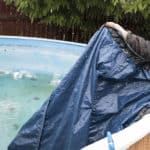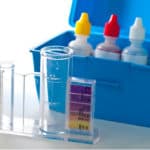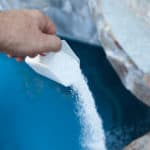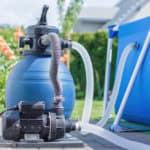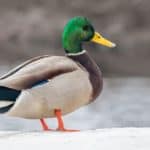Splash water to Aerate a pond. If you want your pond to be full of life, with its own thriving ecosystem, then you need to ensure that it is getting enough oxygen. Especially if you keep fish or other animals of any kind in the pond! Use waterfalls, bubblers or spray fountains to add oxygen as a mechanical mean and you can add plants as a natural way to add oxygen.
There are many different factors that affect the amount of oxygen that your pond has, such as temperature and air pressure, and even the type and amount of plants within the pond itself.

But if for whatever reason, your pond doesn’t have enough oxygen, then aerating it might be the best solution.
When we talk about aerating a pond, we’re talking about turning over the water, creating a flow, and allowing air to enter into the equation so that the pond becomes oxygenated.
There are many different ways of doing this, with different systems and tools that can help you achieve the needed results.
But what is the best way to aerate a pond?
The truth is that it depends. Not all aeration methods will be the best for all ponds, and different people will find that different methods work better or worse, according to their personal needs and preferences.
So instead, let’s take a look at the main ways to aerate a pond, with some pros and cons, and you can choose the one best suited to you!
A fountain pump:
A fountain pump will lift the water from the bottom of the pond, launching it up through the fountain, and then letting it splash back into the pond, in a continuous cycle. This is a great way to aerate a pond, ensuring the oxygen levels are even across the entire surface.
Pros:
- A fountain pump can also serve as a decorative addition to your pond
- Effective aeration that covers large areas of space, for even oxygen levels
- There are many different ways of powering a fountain pump
Cons:
- Fountain pumps are usually turned off during the night, and that is the time in which more oxygen is needed in the pond
- Some find fountain pumps to be annoying
Waterfalls:
Waterfalls are an excellent method of aeration. The water collects extra oxygen as it falls down into the pond, and the crash of the water creates movement within the pond to keep the water flowing and the oxygen spreading evenly.
Pros:
- Waterfalls can look amazing in a pond, and act as a decorative addition
- Fish tend to congregate under waterfalls during the night when the oxygen levels are lower, so it’s a great way to mimic nature!
- It’s a highly efficient method of aeration
Cons:
- As it is within a pond, you will need something to pump the water back to the top part of the pond, so that the waterfall keeps on running and there’s a cycle
An air pump:
An air pump is one of the most common methods of aeration for a pond. There are many different types of pond aerators, powered in different ways and featuring different designs.
Air pumps sit outside of the pond, connected to a diffuser that is most often placed at the deepest part of the pond. The air pump feeds air into the pond, and this creates movement and flows within the water, helping aerate and to spread the oxygen evenly.
Pros:
- A highly effective form of aeration
- There are many different designs to choose from, to better suit the specific needs of your pond
- They can be very discreet so that you barely notice them aerating the pond
Cons:
- Not all air pumps are suitable for outdoor use or weatherproof, which limits their use
An air blower:
Air blowers are essentially the same as an air pump, but they’re a lot bigger and designed for especially large ponds. Therefore, they are able to pump larger amounts of air, for aeration on a bigger scale.
Pros:
- They are a highly effective method of aeration
- Affordable and easy to find, with many different designs
Cons:
- They can be too big, and therefore hard to hide away in a convenient position
How can I aerate my pond cheaply?
The first trick to not spending too much on aerating your pond is to acknowledge that you don’t have to aerate it 24/7.
But if you’re going to choose between aeration at day or at night, we recommend you do it at night, as that is when the pond will be lacking the most oxygen. Therefore, aerating at night will be a lot more useful and effective.
Other things you can do to make your pond aeration cheaper:
- Use solar-powered pumps that do not require any electricity or energy expense
- Use water from natural resources, rather than from the tap. Such as rainwater, or water from a nearby stream or other body of water.
- Design your pond so that aeration happens more naturally, that way you will not have to put as much money towards forcing aeration to occur.
How do you aerate a pond without electricity?
Some of the most common aeration methods involve a pump of some sort, such as air pumps, air blowers, or even fountain pumps. Electricity powers these mechanisms, and keeps the water moving and flowing.
But what if you want to aerate your pond without the use of electricity? After all, electricity would be an added cost.
The answer is simple, get non-electric pumps! There are plenty available in the market, with most being solar-powered. They will charge throughout the day and will be able to function 24/7 without the need for electricity.
Can you aerate a pond too much?
As a general rule, there is no such thing as too much aeration. Aeration simply keeps the water from the pond in movement, so that the oxygen is evenly spread across the entire area.
However, in some specific ponds, depending on the type of fish or animals that you have living in it, too much aeration might cause problems. Basically, if there is too much aeration, then the pond becomes saturated with oxygen levels, and this can be dangerous for some species of fish.
But as we mentioned, as a general rule, this will not be the case, and you should not have to be worried about aerating too much.
Although you should remember that you also don’t need to be constantly aerating the pond, 24/7. Aerating should be a boost if the pond is lacking in oxygen levels.
Does a waterfall oxygenate a pond?
A waterfall can indeed oxygenate a pond. In fact, a waterfall is an excellent form of aeration, and it is very commonly used to increase the oxygen levels within ponds.
As the water falls, it absorbs and collects extra oxygen from the air, which it then takes into the pond, increasing the overall levels.
But on top of that, the crash of the falling water against the surface of the pond causes movement and flow within the pond water, so that the oxygen can spread evenly throughout the entire area.
For example, in nature, if the water is lacking in oxygen levels, fish will often congregate beneath a waterfall. So it’s 100% guaranteed to oxygenate!

